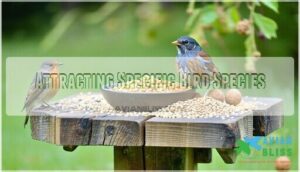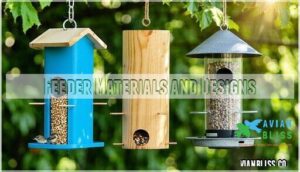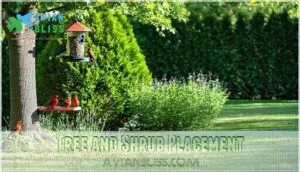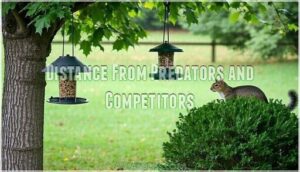This site is supported by our readers. We may earn a commission, at no cost to you, if you purchase through links.
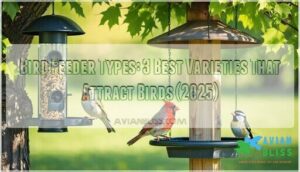 You’ll find three main bird feeder types that’ll transform your yard into a bird paradise.
You’ll find three main bird feeder types that’ll transform your yard into a bird paradise.
Tube feeders work perfectly for seed-loving songbirds like finches and chickadees, with multiple perches and weather protection.
Platform feeders attract ground-feeding species such as cardinals and juncos, offering easy access to various seed types.
Suet feeders draw woodpeckers, nuthatches, and other insect-eating birds with high-energy fat cakes.
Each feeder type serves different bird species and feeding behaviors, so choosing the right combination depends on which birds you want to attract.
The secret lies in understanding what makes each feeder irresistible to specific species, and this is key to creating a yard that is a haven for the birds you wish to attract.
Table Of Contents
- Key Takeaways
- Bird Feeder Basics
- Feeder Types Comparison
- Top 3 Bird Feeders
- Bird Feeder Placement
- Choosing Right Bird Feeder
- Frequently Asked Questions (FAQs)
- What are the different types of bird feeders?
- How to choose the right feeder for different types of birds?
- What is a good bird feeder?
- How do I choose a bird feeder?
- What type of bird feeders do birds like best?
- What is the 5 7 9 rule for bird feeders?
- What are the three types of feeders?
- What kind of bird feeder is best for blue jays?
- What type of feeder do birds prefer?
- What is a hopper style bird feeder?
- Conclusion
Key Takeaways
- Choose feeders based on your target birds – tube feeders attract finches and chickadees, platform feeders welcome cardinals and ground-feeders, while suet feeders draw woodpeckers and nuthatches
- You’ll get better results with proper placement – position feeders 10-15 feet from cover for safety, use squirrel baffles, and provide morning sun with afternoon shade protection
- Seed selection matters more than you’d think – black oil sunflower seeds attract 89% of feeder species, while nyjer specifically targets finches and safflower deters squirrels
- Regular maintenance keeps birds healthy and coming back – clean feeders every two weeks with a dilute bleach solution, refill weekly, and immediately remove wet or moldy seed to prevent disease
Bird Feeder Basics
You’ll need to understand the basic types of bird feeders before choosing the best one for your yard.
Each feeder type attracts different bird species and offers unique advantages for both birds and birdwatchers.
Tray or Platform Feeders
Unlike traditional bird feeders, platform feeders offer an open design that welcomes ground feeders like sparrows, juncos, and doves.
These tray-style feeders accommodate various seed varieties while providing unobstructed views of your feathered visitors.
Consider a durable platform option for long-lasting use.
However, their accessibility makes squirrel deterrents and weather protection essential considerations for successful bird feeding.
Tube Feeders
Why settle for basic bird feeding when tube feeders offer superior seed protection and targeted bird attraction?
These cylindrical feeders excel at dispensing nyjer seeds to finches while keeping food fresh and dry. You can explore various tube feeder models online.
- Seed Protection: Weather-resistant design prevents spoilage and contamination from rain and bird droppings
- Bird Size Selection: Small perches naturally filter out larger, aggressive species while welcoming finches and chickadees
- Material Durability: Heavy-duty plastic construction withstands outdoor elements and frequent use
- Cleaning Frequency: Monthly bleach solution cleaning prevents disease transmission between visiting birds
- Squirrel Baffles: Compatible with deterrent systems to protect seeds from persistent raiders
Window Feeders
Window feeders offer exceptional visibility for close-up bird watching through your glass.
These compact feeders use suction cups or window mounts for easy installation, attracting small birds like finches and chickadees.
Their proximity helps prevent window collisions while providing excellent bird safety.
For a variety of options, consider exploring online retailers.
Minimal seed spillage keeps your space tidy, though squirrel deterrents aren’t typically needed due to challenging access.
Suet Feeders
Suet feeders offer high-energy nutrition that attracts woodpeckers, nuthatches, chickadees, and wrens year-round.
These wire cages hold suet cakes, balls, or raw suet mixed with seeds.
Seasonal suet varieties provide targeted nutrition – winter blends offer extra calories while summer formulas resist melting.
DIY suet recipes let you customize ingredients for local birds.
Proper feeder placement on tree trunks or poles with squirrel deterrents maximizes success.
Many enthusiasts choose hanging single suet feeders for their simplicity.
Feeder Types Comparison
You’ll discover that choosing the right feeder type depends on which birds you want to attract and your specific backyard conditions.
Each feeder design offers unique advantages, from the versatility of platform feeders to the specialized attraction power of tube and suet feeders.
Attracting Specific Bird Species
Different bird species show distinct preferences when choosing bird feeders.
Tube feeders attract smaller, agile birds like chickadees and finches, while platform feeders welcome ground-feeding species such as sparrows and doves.
Understanding these bird behavior patterns helps you select the right feeder placement and seed preferences for your target species.
Platform feeders, for example, are often favored by birds seeking spacious feeding areas.
| Feeder Type | Primary Bird Species |
|---|---|
| Tube Feeders | Chickadees, finches, nuthatches |
| Platform Feeders | Sparrows, doves, jays, grosbeaks |
| Nyjer Feeders | Goldfinches, siskins, redpolls |
| Suet Feeders | Woodpeckers, wrens, nuthatches |
| Nectar Feeders | Hummingbirds, orioles |
Regional variations and seasonal changes affect which bird species visit your feeders.
Northern areas see more woodpeckers at suet feeders during winter, while southern regions attract year-round hummingbird activity.
Bird feeding success depends on matching feeder types with local bird populations and their seasonal migration patterns.
Feeder Materials and Designs
Your feeder’s construction directly impacts its performance and longevity. Modern bird feeder materials have evolved from basic wood to advanced polymers that resist weather damage and pest interference.
Regular cleaning is essential, especially given the potential for avian flu outbreaks.
| Material Type | Key Benefits |
|---|---|
| Recycled Plastic | Lifetime durability, fade-resistant |
| Cedar Wood | Natural aesthetics, requires maintenance |
| Polycarbonate | UV-stable, squirrel-proof construction |
| Powder-coated Metal | Rust-resistant, easy cleaning |
| Resin Composite | Weather-resistant, power-washable |
Smart design principles focus on material durability and cleaning ease. Weather resistance protects seeds from moisture while squirrel proofing prevents costly damage. Choose bird feeder construction that balances design aesthetics with practical functionality for your specific backyard conditions.
Seed Types and Bird Preferences
Your seed selection determines which birds visit your yard.
Black oil sunflower seeds attract 89% of feeder species, while nyjer targets finches specifically.
Seed nutritional value affects bird health—sunflower provides 29% fat content.
Regional seed blends work better than generic mixes.
Consider seed size preference and spoilage rates when choosing.
| Seed Type | Primary Birds Attracted | Fat Content |
|---|---|---|
| Black Oil Sunflower | Cardinals, finches, chickadees | 27-29% |
| Nyjer/Thistle | Goldfinches, siskins, redpolls | 17-30% protein |
| Safflower | Cardinals, grosbeaks, woodpeckers | 17% |
Top 3 Bird Feeders
After comparing dozens of feeders based on durability, bird attraction, and ease of maintenance, these three models consistently outperform competitors in real-world testing.
You’ll find each option targets different feeding preferences while offering reliable construction that withstands weather and wildlife interference, providing a durable solution.
1. Woodlink Large Premier Going Green Feeder
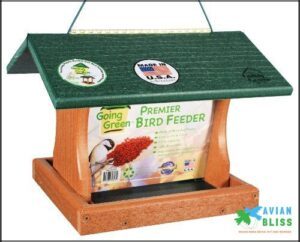
Built from recycled materials equivalent to 1,200 milk jugs, the Woodlink Large Premier Going Green Feeder stands out as an eco-friendly champion.
Transform 1,200 milk jugs into a bird-feeding powerhouse that’s built to last.
You’ll appreciate its 5.5-pound seed capacity and dual-sided ranch-style design that accommodates multiple birds without the usual squabbling.
The powder-coated metal screen bottom guarantees proper drainage while the hinged roof makes refilling straightforward.
At 6.5 pounds empty, it’s sturdy enough to withstand harsh weather conditions and curious wildlife.
Best For: Eco-conscious bird enthusiasts seeking a heavy-duty, weather-resistant feeder that can attract a diverse range of birds with minimal maintenance.
- Heavy weight requires a sturdy support and may be challenging to install for some users
- Higher price point compared to similar-sized plastic or wood feeders
- Reports of inadequate packaging leading to occasional damage during shipping
- Made from 90% post-consumer recycled plastic, promoting sustainability and durability
- Large capacity and dual-sided design attract more birds without frequent refilling
- Easy to clean with hinged roof, removable panels, and non-stick surfaces
2. Woodlink Platform Bird Feeder 3 in 1

You’ll find the Woodlink Platform Bird Feeder 3 in 1 stands out with its remarkable versatility.
This cedar-constructed feeder offers three mounting options: hanging, pole-mounting, or ground placement with foldable legs.
It holds up to 3 pounds of mixed seed and features a removable powder-coated screen base for easy drainage and cleaning.
The open platform design attracts diverse species from cardinals to woodpeckers, making it perfect for backyard birders who want maximum variety at their feeding station, which is a great example of its remarkable design.
Best For: Backyard bird enthusiasts who want a versatile, durable feeder that attracts a wide variety of bird species.
- Mounting hardware for pole or post not included and must be purchased separately.
- Larger, open design can attract squirrels and nuisance birds like crows or grackles.
- Higher price point compared to many basic bird feeders.
- Flexible placement: hang, pole-mount, or use on the ground with included foldable legs.
- Easy to clean and maintain with a removable, powder-coated screen base.
- Attracts many bird species thanks to the open platform and 3-pound seed capacity.
3. Droll Yankees Bird Feeder 12 Ports
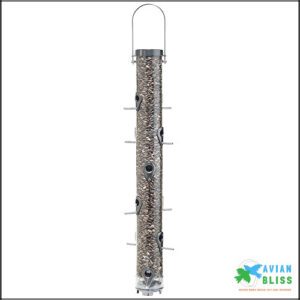
This premium tube feeder delivers exceptional value with its 4-pound capacity and 12 feeding ports that accommodate multiple birds simultaneously.
You’ll appreciate the UV-stabilized polycarbonate construction that resists yellowing and cracking through decades of outdoor use.
The metal components feature zinc-plated finishes that withstand squirrel teeth and bear attacks, while the twist-and-release base enables tool-free cleaning in seconds.
Cardinals, chickadees, finches, and nuthatches will flock to this durable investment that’s designed for black-oil sunflower seeds and mixed blends.
Best For: Bird enthusiasts seeking a durable, large-capacity feeder that attracts a wide variety of songbirds and withstands tough weather and animal interference.
- Higher price point than standard feeders ($64)
- Feeding ports may be too small for larger birds like cardinals
- Some users report missing stainless steel hanging wire in packaging
- UV-stabilized polycarbonate and metal components resist damage from weather, bears, and squirrels
- 12 feeding ports allow multiple birds to feed at once without crowding
- Easy to clean and refill with tool-free twist-and-release base
Bird Feeder Placement
You’ll need to examine several key factors when positioning your bird feeders to maximize bird visits and guarantee their safety.
Proper placement affects which species you’ll attract, how often they’ll visit, and whether they’ll return to make your feeder a regular stop.
Tree and Shrub Placement
Strategic placement near trees and shrubs creates natural feeding corridors that enhance bird feeder types‘ effectiveness.
Well-placed feeders turn your yard into a natural bird highway.
Natural cover provides essential predator protection while supporting species attraction through familiar habitat elements.
- Position feeders 10-12 feet from dense shrubs – offers quick escape routes while preventing easy predator ambushes from cover
- Choose deciduous trees for seasonal weather shielding – provides summer shade and winter wind protection for platform bird feeders and tube bird feeders
- Integrate hopper bird feeders among native plantings – creates aesthetic integration that feels natural while maintaining accessibility considerations for refilling
Regular Cleaning and Refilling
Proper bird feeder maintenance keeps your backyard visitors healthy and happy. Clean feeders every two weeks with a dilute bleach solution to prevent disease transmission.
Check seed levels weekly and refill as needed. Remove wet or moldy seed immediately to avoid contamination. Consider disassembling feeders completely to guarantee thorough cleaning of all parts.
| Task | Frequency | Method |
|---|---|---|
| Deep cleaning bird feeders | Every 2 weeks | Bleach solution (1:9 ratio) |
| Bird feeder refilling | Weekly check | Remove old seed first |
| Mold prevention inspection | After rain/snow | Discard wet seed immediately |
| Hygiene practices review | Monthly | Replace worn feeding ports |
Regular bird feeder cleaning prevents seed spoilage and maintains proper hygiene practices for visiting birds.
Distance From Predators and Competitors
Position your bird feeder placement 10-15 feet from dense cover to prevent predator ambushes while allowing quick escapes.
Safe distances protect birds from cats lurking in bushes.
Strategic spacing reduces competition and territory defense issues:
- Install squirrel baffles on your bird feeder pole to block jumping access
- Use multiple feeders at varying heights for different species
- Choose squirrel proof feeders with weight-activated perches
Your bird feeder hanger should create clear sight lines for early predator detection.
Sun and Weather Protection
Weather elements can quickly turn your bird feeder investment into a costly mistake.
Choose feeders with overhang design and drainage solutions to prevent seed spoilage from rain.
Material degradation occurs faster in direct sunlight, so location considerations matter for bird feeder durability.
Position feeders where morning sun reaches them but afternoon shade protects against harsh heat, ensuring ideal bird feeder weather protection with proper drainage solutions.
Choosing Right Bird Feeder
Selecting the right bird feeder depends on four key factors that’ll determine your backyard birding success.
You’ll need to take into account your budget, target bird species, available space, and how much maintenance you’re willing to handle.
Budget and Cost Considerations
Budget considerations can make or break your bird feeding journey.
Basic plastic bird feeders start around $7, while premium models reach $269.
You’ll spend roughly $60 annually on seed, though bulk purchases of 13-25kg bags offer better value.
DIY feeders using recycled materials cut initial costs substantially.
Quality metal feeders cost more upfront but provide long-term savings through durability and can be a better option for long-term use, considering the annual cost of seed.
Bird Species and Seed Preferences
Before diving into bird feeders, you’ll want to match your seed variety to regional birds in your area.
Cardinals prefer sunflower seeds and safflower, while finch favorites include nyjer and millet.
Understanding seasonal diets helps too—birds need high-fat seeds during winter months.
Research local bird species first, then select appropriate seed feeders and bird seed types for effective bird feeding success.
Space and Placement Constraints
Your apartment’s balcony or small yard doesn’t limit bird watching dreams.
Urban limitations call for creative solutions like window bird feeders that stick directly to glass or compact platform bird feeders designed for tight spaces.
Balcony feeders work perfectly in apartment solutions, while small yards benefit from multi-feeder setup strategies that maximize vertical space without overwhelming your area.
To prevent window collisions, consider placing feeders within three feet of windows or further than fifteen feet, using compact platform designs to minimize space.
Ease of Maintenance and Cleaning
Maintenance matters when choosing bird feeders.
Tube feeders with wide openings simplify cleaning frequency requirements, while complex designs increase disassembly complexity.
Choose materials with good drainage to prevent mold prevention issues.
Plastic feeders resist bleach solution cleaning better than wood.
Regular cleaning prevents diseases and improves pest control around your yard, which is a crucial aspect of maintaining a healthy environment, and it also supports overall yard health.
Frequently Asked Questions (FAQs)
What are the different types of bird feeders?
You’ll discover five main feeder types that attract different birds.
Tube feeders suit finches and chickadees, while hopper feeders welcome cardinals and jays.
Platform feeders attract ground-feeders, suet feeders draw woodpeckers, and nectar feeders bring hummingbirds to your yard.
How to choose the right feeder for different types of birds?
Match your feeder to your target birds: tube feeders for finches and chickadees, hopper feeders for cardinals and jays.
Suet feeders are for woodpeckers, and platform feeders are for ground-feeding species like sparrows.
What is a good bird feeder?
You’ll want a tube feeder for versatility—it protects seeds from weather, prevents waste from droppings, and attracts finches, chickadees, and cardinals while deterring larger pests effectively.
How do I choose a bird feeder?
Surprisingly, choosing the perfect feeder isn’t about finding one-size-fits-all solutions.
Consider which birds you’d like to attract, your maintenance preferences, and squirrel challenges.
Match feeder type to target species—tube feeders for finches, suet for woodpeckers.
What type of bird feeders do birds like best?
Birds prefer hopper and tray feeders most because they accommodate diverse species and feeding styles.
These designs attract cardinals, jays, finches, and sparrows while offering easy access and visibility during feeding sessions.
What is the 5 7 9 rule for bird feeders?
Nothing’s more frustrating than squirrels raiding your precious bird buffet! The 5-7-9 rule’s your secret weapon: place feeders 5 feet high, 7 feet from launching points, with nothing 9 feet above.
What are the three types of feeders?
Three main feeder categories serve different bird species effectively.
Tube feeders attract finches and chickadees with enclosed seed chambers.
Platform feeders welcome ground-feeding birds like sparrows and cardinals.
Suet feeders provide high-energy fat for woodpeckers and nuthatches.
What kind of bird feeder is best for blue jays?
For blue jays, you’ll want a tray or hopper feeder since they’re larger birds.
These feeders accommodate their size and feeding style perfectly.
Peanut feeders also work great for attracting these intelligent, social birds.
What type of feeder do birds prefer?
Like Goldilocks searching for what’s "just right," you’ll find birds don’t have one universal preference.
Tray feeders attract the widest variety since they accommodate different feeding styles and bird sizes effectively.
What is a hopper style bird feeder?
A hopper feeder resembles a tiny house with a pitched roof that protects seed from weather.
It’s got a central chamber that automatically dispenses food as birds eat, keeping your feathered friends happy for days.
Conclusion
Studies show backyard bird feeders support over 57 million households in creating wildlife habitats.
You’ve learned that different bird feeder types attract specific species through targeted design features.
Tube feeders excel for small songbirds, platform feeders accommodate ground-feeders, and suet feeders draw woodpeckers.
Success depends on matching feeder selection to your desired bird species, proper placement, and consistent maintenance.
Start with one type, observe which birds visit, then expand your collection strategically to maximize diversity in your backyard bird community, and ultimately create a thriving backyard bird community.

